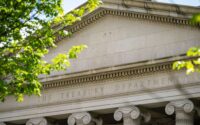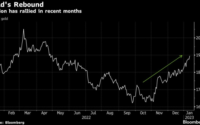Free Money Turned Brains to Mush, Now Some Banks Fail
The Fed’s rate hikes and QT didn’t break anything except consensual hallucination.
By Wolf Richter. This is the transcript of my podcast on Sunday, February 26, THE WOLF STREET REPORT.
There’s a lot of talk that the Federal Reserve broke the banks with its rate hikes and quantitative tightening, and that the Fed killed Silicon Valley Bank, etc. etc.
But the Fed didn’t break anything with its rate hikes and QT, except consensual hallucination, as I call it, in the Free Money era.
What did break Silicon Valley Bank was the Fed’s refusal to regulate it properly. The Fed is the dominant banking regulator. And it just let the bank do its thing, and it loosened its regulations for mid-size banks in 2018, and when the Fed as banking regulator started getting nervous about it, it still didn’t actually push the bank to fix its problems, and it still let it do its thing. The collapse of Silicon Valley Bank was a regulatory failure.
And it was a reckless management failure, obviously, and those folks should spend some quality time in the hoosegow.
But there’s another issue that forms the foundation for all this – and the Fed is solely responsible for it: The 14 years of free money policies by the Fed. From what we now know, free money is like a virus that turns brains to mush.
The Fed has broken all kinds of things with its interest-rate repression and money printing that have created this era of Free Money. The biggest thing it has broken – and this is a huge thing – is price stability.
After 40 years of relatively calm inflation, we now have raging inflation, and this inflation has moved from goods to services, and services is nearly two-thirds of consumer spending, and inflation is now raging in services at the worst pace in 40 years, and in services is where inflation is very difficult to eradicate.
Way too late, the Fed is now trying to actually fix this huge thing – price stability – that it has broken.
So we got this huge mess of heavy-breathing inflation that the Fed has been trying to address over the past 12 months, after having fallen at least a year behind. The Fed has been addressing this inflation with rate hikes and quantitative tightening. So that’s the end of free money.
And now, in addition to this heavy breathing inflation, we have a crisis in the banking system because the brains of some banking executives had been turned to mush by 14 years of free money.
And when I say “free money” with regards to banks, I mean it literally. Since 2008, banks have been borrowing from depositors at 0% interest or near 0% interest. Even today, even as some banks are trying to attract more deposits by offering higher interest rates, even today when the Fed’s short-term rates are near 5%, the average interest rate on savings accounts is still only 0.4%. Even today, 0.4%.
But until March last year, it was 0.06%. For all practical purposes this is 0%. It means that on savings of $100,000, the bank would pay its customers just $60 in interest, when it should have paid them $3,000 or $4,000 in interest. For checking accounts and other transaction accounts, the banks paid 0% interest. For banks this was the era of free money – and a lot of free money.
Banks now have about $17 trillion in deposits, and that’s $17 trillion in free money for the banks, thanks to the Fed’s 14 years of interest rate repression.
The Fed’s monetary policies have allowed and encourage banks to screw their customers – to just take their money and not pay them any interest on it.
And so now this free-money era is coming to a gradual end – the banks are mostly still not paying interest. As I said, the average savings account interest rate is 0.4% and the average checking account interest rate is 0%. But gradually banks are having to offer higher rates or else customers might yank their money out. And suddenly some banks get in trouble?
Banks got in trouble because a bunch of these genius bankers could not even imagine life without free money, and they recklessly refused to prepare for the end of free money. And they made an awful mess.
It goes like this – and many observers, including me, have hammered on it fruitlessly for years: The Fed repressed short-term interest rates to near 0%, and it bought trillions of dollars of bonds via QE, thereby handing out money that then went chasing after assets of all kinds, and a lot of it washed into banks, causing the biggest asset price bubble ever, and causing long-term yields to plunge.
The Fed’s interest rate repression and asset-price inflation started in 2008 and continued in waves, backing off timidly in 2016-2018, then going hog-wild in 2020-2021. It will go down in history as the biggest monetary-policy idiocy ever.
Enough of the decision makers at banks – but obviously not all that many of them – believed that money would always be free, and they believed that even if money is briefly less free, it would soon be free again.
And enough of them based their banking decisions on those believes. Free money is like a virus that turns human brains to mush.
The Fed gave them two years to address these issues at their banks. As inflation was surging in early 2021, the Fed refused to hike rates. But other central banks could figure out what was coming from the Fed, they started to front-run the Fed to protect their currencies for the moment when the Fed would start hiking rates. Among them are the central banks of Brazil and Mexico that, starting in the spring of 2021, implemented monster rate hikes. They saw what the Fed would do, and the front-ran the Fed to protect their currencies, and it worked, the currencies of Brazil and Mexico fared very well against the dollar.
Only a bunch of genius-bankers in the US didn’t get it because they didn’t want to get it because their brains had been turned to mush by free money. And they were thinking about bonuses and stock compensation and pumping up stock prices, just look at the stock charts of these banks.
For example, SVB Financial, which owned Silicon Valley Bank, well its stock price tripled in two years to $750 a share, before it collapsed. When you look at these charts, you instinctively understand the term “consensual hallucination.”
With all this going on for SVB and some other banks, preparing for the end of free money just wasn’t possible because it might have put a damper on the run-up in the stock price.
I’ve written a bunch of articles about SVB Financial, starting in the summer last year, when I started making parallels to the dotcom bust. Silicon Valley Bank survived the dotcom bust; it didn’t survive this bust.
Then the Fed indicated in the fall of 2021 that it would hike rates, and then it did hike rates in early 2022, and then faster in mid-2022, as inflation was blowing out. And these highly paid geniuses still didn’t prepare for higher rates.
Some of these bank managers just blew off raging inflation and the Fed. And they believed in the “Free Money Forever” mantra, and they refused to hedge their interest rate risk, and they refused to unload their long-term Treasury securities and mortgage-backed securities that would decline in market price as long-term rates would go up. Everyone knows this. It’s not a secret. It’s one of the fundamental principles you learn in finance 101 in grade school or whatever. And those bankers knew that too but refused to act because their brains had turned to mush.
Throughout the rate-hike cycle, long-term Treasury yields were below the short-term yields. They were lower because banks and other big holders thought all this was just transitory or whatever, and they kept these securities and bought these securities instead of unloading them.
They could have unloaded these long-term securities in 2021 and earlier in 2022 without losses or big losses. And when rates started rising, these geniuses believed in the Fed-pivot that was being mongered on Wall Street and in the media and they still refused to hedge their interest rate risk and unload these securities at a much smaller loss than now.
What they did was a stock pumping scheme, and they were busy paying themselves big bonuses and stock compensation packages, and they were busy selling their own stock holdings and getting richer.
Hedging against interest rate risk – meaning against the risk that interest rates will rise in the future – is a fundamental thing that banks do. So when interest rates rise, their long-term fixed-rate loans, such as mortgages or industrial loans, and their holdings of long-term securities, they all would lose value. But banks would make money on their hedges and it would balance out to some extent.
But hedging is not free. It would have reduced the income during the Free Money era. And so Silicon Valley Bank didn’t hedge at all its interest rate risk. That was management recklessness.
At the same time, banks ripped off their depositors by paying them 0% or near 0% in interest while gorging on long-term securities with yields of 2% or thereabouts, making money on this spread, and they figured they’d always have access to this free money from their depositors.
When I say that free money turns brains to mush, I mean it literally for some bankers.
And then depositors started pulling their money out for a variety of reasons, including that they got tired of getting screwed on the interest, which was still largely 0%. And they knew that the banks had huge unrealized losses on their long-term securities that they had bought years ago with a yield of 2%, and when the market moved to 4%, those securities lost value, so banks couldn’t sell them without booking a big loss, and so they didn’t sell them, and the situation just kept getting worse, and it’s all disclosed in the financial statements, and people started reading them, and it’s like wow, I’m outa here.
And they yanked their deposits out, which forced the banks to actually sell those securities at a loss in order to fund the deposit outflow that had turned into a torrent, and it all spiraled into a mess. Two of these banks collapsed, a few others are on the verge of collapse, and the Fed and the FDIC are now propping them up. These geniuses that run or ran these banks need to spend some quality time in the hoosegow.
But the Fed’s rate hikes and QT didn’t break anything except consensual hallucination, which was the standard condition during the free-money era. And that’s a good thing. Higher interest rates and QT have been observed in the wild to reverse the process of brains having turned to mush. And that’s a good thing too.
You can subscribe to the podcast of THE WOLF STREET REPORT on YouTube or download it wherever you get your podcasts.
Enjoy reading WOLF STREET and want to support it? You can donate. I appreciate it immensely. Click on the beer and iced-tea mug to find out how:

Would you like to be notified via email when WOLF STREET publishes a new article? Sign up here.
![]()
[ad_2]
Source link


